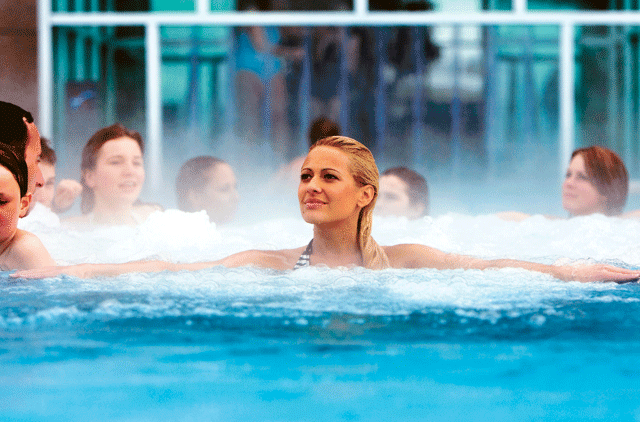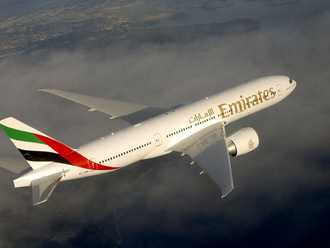Forget breakfast in bed, breakfast in the pool is the new height of luxury. We’re floating in a heated indoor swimming pool in Leukerbad, and individual trays with open sandwiches, croissants and coffee are floated over to us. And in case we want more, there’s a massive buffet we can swim across to for a top-up.
We’re living it up in the Swiss health resort of Leukerbad, where the well-heeled have thronged to take the waters since Roman times. It was already being marketed as a spa resort in 1501, but the town only really became particularly popular in the nineteenth century. Today, it clocks more than 800,000 tourism overnights annually, according to its tourism board.
Over 3.9 million litres of sulphurous water that has been cooled to temperatures that the human body can bear flow through its 30 thermal pools. The many bathrobe-clad visitors that are a common sight on these streets have come in search of both relaxation and rehabilitation. Besides several four- and five-star hotel spas offering a slew of therapies, an Olympic medical centre treats musculoskeletal and neurological disorders.
Fewer than 1 per cent of visitors are Gulf nationals, but David Kestens, marketing director at Leukerbad Tourism, believes that will change once 51 Degrees, a new five-star hotel being built by the Swiss Development Group, opens its doors in 2015. “Gulf visitors want rooms with private pools, so we don’t expect to see a big increase in tourists from the GCC until we have those facilities in place,” he tells GN Focus in Leukerbad.
For now, he’s concentrating his efforts both on such traditional source markets as Germany and France, as well as newer travelling countries such as Russia and China. “In terms of marketing, we were once known as a place where you came to be cured, but then we put the emphasis on the wellness market. We want to turn the focus back again now,” he says.
Medicine, not wellness
Leukerbad is only one of several Swiss resorts that is increasingly diversifying away from the established wellness travel segment into medical tourism. With its high density of hospitals and clinics as well as a reputation for medical advances, Switzerland is already a treatment centre of choice for well-heeled patients, including several regional leaders.
Already, around 10 per cent of all inpatient treatments are carried out on international visitors, according to Swiss Health, an agency set up jointly with the government’s export specialist, OSEC, in 2010 to market the country as a health destination. It promotes about 50 specific hospitals in key cities such as Basel, Zurich and Lucerne.
Forecasting agency Euromonitor expects all these marketing efforts to boost medical tourism receipts 22 per cent over the period from 2011-2016, while spa revenue is expected to stay healthy at 10 per cent. In 2010, medical tourism receipts were CHF850 million, by 2015 these could rise to CHF1.02 billion, prompting marketers to refocus their efforts.
“While the emphasis is still on wellness tourism, there is now an emergence of political will to develop the sectors of health treatments, medical wellness and health prophylaxis,” the agency said in a recent report on the sector, highlights of which were shared with GN Focus.
Since foreign patients often generate more revenue than Swiss private patients, the accent is increasingly on the middle classes from newly wealthy countries in Eastern Europe, the Middle East and Asia.
Many countries, including the likes of India, Singapore and Tunisia now vie for the globalised tourist’s health dollars, but Swiss officials believe the country’s unique tourist attractions and luxury shops combine beautifully with its medical facilities. “The growing number of patients from all over the world not only trust high class medical treatments from a simple aesthetic treatment to a severe surgical intervention, but also have trust in the reliable economical and political surrounding and take the opportunity to combine the medical stay with holiday, leisure and shopping,” Gregor Frei, Managing Director of Swiss Health, tells GN Focus.
Variety of treatments
Travellers come to Switzerland for treatments in a variety of fields, he adds, including cardiac- and neurosurgery, urology, traumatology, orthopaedics, oncology, endocrinology, weight loss and cosmetic medicine. And how much might these treatments cost? Kestens offers an example. A seven-night slimming cure at the top end of the market, at the five-star Sources des Alpes in Leukerbad, costs CHF4,042.50 per person in a double room. Included are a range of treatments based on cryogenics and meals devised to complement the plan. Treatments such as Clinique La Prairie’s patented CLP Extract therapy, which uses anti-ageing extracts from the live cells of sheep embryos, can cost five times as much.
Part of Swiss Health’s mandate is to help smaller hospitals with their marketing outside Switzerland. Several private players already operate in the same arena, capitalising on the country’s excellent facilities. One such company, Swixmed, positions itself on its website as an organiser of both primary treatments and remote second opinions, assisting with visas, accommodation, local transport and multilingual companions, as well as monitoring costs and bills from various service providers.
Elsewhere, hospitals team with hotels to bridge the health care gap. In the picture-postcard city of Lucerne, four hospitals including a paraplegic centre, have been working together with six hotels since 2006 to target affluent guests aged between 40 and 60 with an interest in travelling in small or individual groups. The agency, LucerneHealth, combines products and services from both sectors into packages aimed at enhancing the guest experience. Their most recurrent patients are from Russia, the Middle East and Asia, LucerneHealth Managing Director Dieter Baumgartner told delegates at a medical tourism conference this June.
Across Switzerland, Frei says there are about 100 medical institutions that attract patients from the Gulf. He can’t say exactly how many foreign tourists seek medical advice or treatment, since they only need a tourist visa, but he estimates that 10 per cent of all visitors come only for medical reasons or club such visits with business trips or holidays. That doesn’t include companions, who often also stay at the clinic.
Statistics from Swiss Tourism show that in the first eight months of 2012, some 44,000 tourists travelled to Switzerland from the UAE; a 33 per cent year-on-year increase.
Price challenges
While the future appears bright, as facilities are improving, new alliances are set in motion and potential visitors live longer, several challenges remain. Frei agrees there is some way to go before Switzerland can catch up with Germany, which is rather better marketed and consequently, has a stronger reputation.
Euromonitor cites research from the Ecole Hotelière (EHL) in Lausanne, which warns that the next few years will serve to distinguish those areas which can offer a complete package to potential medical visitors. “To do so, hotels [and hospitals] need to understand the needs of the type of medical tourists they may be serving, and develop plans that create new revenue potential based on those needs,” the report said.
Price remains another issue. Euromonitor’s report warned that Switzerland remains comparatively expensive in terms of medical tourism. While the super-rich will continue to consult Swiss doctors, more price-conscious clients might choose comparable facilities in countries such as Hungary.
“Switzerland is not a low-price country,” agreed Frei. “[But] within Switzerland there is a scope in prices and it is worthwhile asking for an offer. There are a wide range of possibilities to find a suitable cost structure.”
In other words, you may not always find that luxury breakfast at a price you’re happy to pay.







